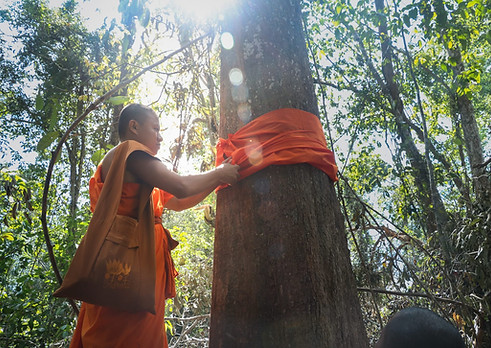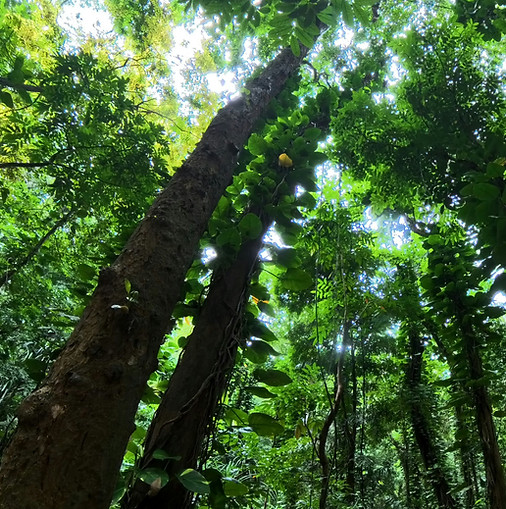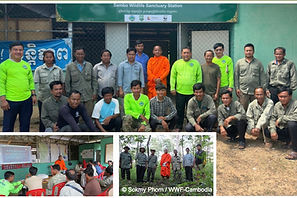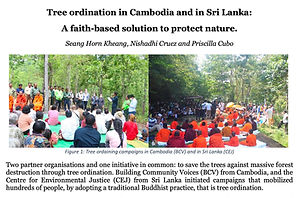
BUDDHISTS &
FORESTS IN
SOUTHEAST ASIA
OVERVIEW
Buddhist monks and communities are protecting forests, rivers and other habitats in Southeast Asia through on-the-ground patrolling, tree growing, advocacy, education and awareness. These ‘eco-monks’ are seen as warriors for the environment and their efforts to protect the forests and habitat are unique and effective. Beginning in Thailand in the 1990s, ‘socially engaged Buddhism’ has spread through Southeast Asia.
'When you ordain a tree, that tree becomes sacred.
Once a tree is ordained, nobody wants to destroy it.'
– Phrakru Pitak Nanthakthun, Abbot at Wat Arunyawas, Nan Province, north-east Thailand,
CAMBODIA
Buddhist monks are leading conservation initiatives across Cambodia. They are patrolling forests to pick up snares and stop illegal hunting, ordaining trees and spreading messages through their pagodas about the need to protect threatened species including the Critically Endangered Irrawaddy dolphin.
Read more about monk-led habitat protection in Cambodia by clicking below.

A Buddhist monk ordains a tree, by Sina, WWF-Cambodia

Monks in Thailand
THAILAND
Over 90% of the population of Thailand practices Buddhism, with Buddhist monks exercising great influence and leadership in local communities. Thai monks have been active in protecting forests, cleaning up rivers and speaking out against dam construction.
Known as ‘Ecology Monks’ (Eco-monks), these leaders seek to preserve the natural environment through practices such as Tree Ordination and the spreading of sustainable practices through awareness, activism and education.
The practice of ordaining trees as a way to protect forest areas started here and spread elsewhere among Buddhist monastic communities in Asia.
MYANMAR
Bemetaw forests are sacred areas that are managed under the auspices of Buddhist monasteries. Bemetaw means ‘threat-free’ in the Burmese language, and no living beings are allowed to be harmed within Bemetaw forests.
Believed to date back to the spread of Buddhism during the 11th century rule of King Anawrahta (1044-1077), the first recorded proclamation of a Bemetaw forest dates to 1859. That is when under King Mindon (1853-1878) a number of Bemetaw forests were established.
While the practice was later partially co-opted under subsequent British colonial rule (1824 – 1948), there are still forests managed by local monasteries today, particularly in the central part of Myanmar.


SRI LANKA
The first major tree ordination ceremony in Sri Lanka was held in 2014 to protest the destruction of the Nilgala Forest. Buddhist monks, over 300 local people and a range of environmental organisations participated, and Muslim religious leaders from the area also joined the event.
Nilgala Forest is deeply significant to the Vedda community, Sri Lanka's Indigenous people, who consider it a sacred ancestral land where their ancestors' spirits dwell. It is one of several forests in Sri Lanka considered sacred, including Udawattakele Rainforest Sanctuary, which lies within Sri Lanka's second city of Kandy, and Sinharaja Forest Reserve, a biodiversity hotspot and a UNESCO World Heritage Site.

TREE ORDINATION
Tree ordination is a practice that originated in Thailand and spread to the Buddhist countries of Cambodia, Vietnam and Sri Lanka. It is a ritual performed by monks, often with community members, as a way to both sanctify and protect the forest. Those who encounter these trees, wrapped in monks’ saffron robes, know the area is sacred, and that if the trees and wildlife are harmed there, they will reap terrible karmic retribution. The revered Cambodian monk, Maha Ghosananda, famously ordained a tree in Ratanakiri province to highlight deforestation. He stated: ‘When we ordained a tree, it became a monk… and we told the people. When you kill the tree, then you kill the monk.'












